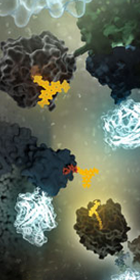This is a guest post from Katarzyna Dubiel, marketing intern in Cellular Analysis and Proteomics.
“The objective of my experiment was to test the NanoBRET™ assay as if I was a customer, independent of the research and development team which develops the assay.”
 Designing and implementing a new assay can be a challenging process with many unexpected troubleshooting steps. We wanted to know what major snags a scientist new to the NanoBRET™ Assay would encounter. To determine this, we reached out to Laurence Delauriere, a senior applications scientist at Promega-France, who had never previously performed a NanoBRET™ assay. Laurence went step-by-step through the experimental process looking at the CRAF-BRAF interaction in multiple cell lines. In an interview, Laurence provided us with some tips and insights from her work implementing the new NanoBRET™ assay.
Designing and implementing a new assay can be a challenging process with many unexpected troubleshooting steps. We wanted to know what major snags a scientist new to the NanoBRET™ Assay would encounter. To determine this, we reached out to Laurence Delauriere, a senior applications scientist at Promega-France, who had never previously performed a NanoBRET™ assay. Laurence went step-by-step through the experimental process looking at the CRAF-BRAF interaction in multiple cell lines. In an interview, Laurence provided us with some tips and insights from her work implementing the new NanoBRET™ assay.
In a few words, can you explain NanoBRET?
“NanoBRET is used to monitor protein: protein interactions in live cells. It is a bioluminescence resonance energy transfer (BRET) based assay that uses NanoLuc® luciferase as the BRET energy donor and HaloTag® protein labeled with the HaloTag® NanoBRET™ 618 fluorescent ligand as the energy acceptor to measure the interaction of two binding partners.”
Can you briefly summarize your experiment? Why did you choose to investigate the CRAF-BRAF interaction?
“…I choose to work with a well-known protein complex, the CRAF-BRAF heterodimer, since an optimized protocol in the human embryonic kidney cell line (HEK293) already existed. These proteins are highly studied for their prominent role in cancer, so I decided to additionally investigate their interactions in a human colon carcinoma cell line (HCT116).”
Laurence used GDC-0879, a compound known to stimulate the CRAF-BRAF interaction, to monitor a protein:protein interaction using NanoBRET in these cell lines. She observed a dose-dependent increase in BRET upon compound treatment in both HEK293 and HCT116 cell lines.
You went step-by-step through assay optimization and development. Do you have any advice or tips for scientists developing a new NanoBRET™ assay?
“First, it’s really important to optimize orientation and placement of the NanoLuc® donor and HaloTag® acceptor fusion tags to obtain the best results. Start with four constructs for each protein: HaloTag N-terminal, HaloTag C-terminal, NanoLuc N-terminal and NanoLuc C-terminal. Transfect cells with the eight combinations and determine which combination gives the best NanoBRET™ ratio. If you already have an inducer or inhibitor of the interaction, I highly recommend testing these with and without the inducer (or inhibitor).”
Related to this, Laurence noticed some unexpected results during this optimization step.
“The plasmid combinations that gave the highest NanoBRET™ ratio (without the inducer) had poor NanoBRET fold changes in presence of the inducer. So, for all my further experiments I used the combination with the highest fold change and not the highest NanoBRET™ signal. That’s why I highly recommend performing the optimization using an inducer (or inhibitor) when possible.”
Additionally, Laurence highly recommended optimizing the donor and acceptor ratio by testing different vector ratios during transfection. She noticed at lower vector ratios (1:1 and 1:10) the fold change with and without compound was larger than at higher ratios (1:100 and 1:1,000). For optimal results, she used these lower vector ratios in her experiments.
Since the HaloTag® protein can be linked to a wide-range of ligands, a single fusion can be used to assay multiple questions. Here, Laurence additionally used the HaloTag to validate the CRAF-BRAF interaction using the HaloTag® Mammalian Pull-Down System.
You used the HaloTag that was already present on your labeled protein to validate the protein:protein interaction, can you speak to how you did this?
“I used the HaloLink™ Resin that binds specifically the HaloTag to purify CRAF-HaloTag complexed and pull out BRAF-NanoLuc. The complex was then released from the resin using the ProTEV Plus protease, which specifically cleaves the link between HaloTag and CRAF. The presence of BRAF-NanoLuc was then assessed using the Nano-Glo® Luciferase Assay. It’s like a co-immunoprecipitation without the antibody.”
Did you consider multiplexing with other assays or tools?
“Yes, I multiplexed the NanoBRET assay with CellTiter-Glo® Luminescent Cell Viability Assay to access the viability of the cells after transfection and drug treatment. I could also have used a cytotoxicity assay such as the CellTox™ Green Cytotoxicity Assay.”
NanoBRET can be applied to a wide-range of experimental questions. Laurence spoke about the benefits of using this kind of assay compared to others.
“First, NanoLuc is extremely bright, allowing for the expression of NanoLuc fusions at very low physiological levels and still providing enough energy for transfer. Second, the HaloTag® NanoBRET™ 618 fluorescent ligand is optimized with reduced spectral overlap, making it an ideal fluorescent acceptor.”
You can read more about Laurence’s CRAF-BRAF assay in the article here. Many thanks to Laurence for taking the time to answer these questions and working through a new assay.
Related Posts
Latest posts by Promega (see all)
- Overcoming qPCR Inhibitors: Strategies for Reliable Quantification - March 13, 2025
- Celebrating Creativity and Innovation: The 2025 Promega Employee Art Showcase - February 4, 2025
- Soft Skills for the Science Lab: Develop Yourself with Promega - November 14, 2024
